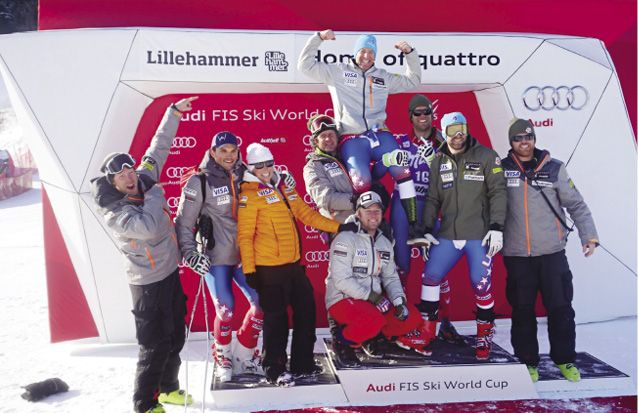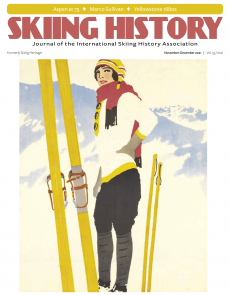SKIING HISTORY
Editor Seth Masia
Managing Editor Greg Ditrinco
Consulting Editor Cindy Hirschfeld
Art Director Edna Baker
Editorial Board
Seth Masia, Chairman
John Allen, Andy Bigford, John Caldwell, Jeremy Davis, Kirby Gilbert, Paul Hooge, Jeff Leich, Ron LeMaster, Bob Soden, Ingrid Wicken
Founding Editors
Morten Lund, Glenn Parkinson
To preserve skiing history and to increase awareness of the sport’s heritage
ISHA Founder
Mason Beekley, 1927–2001
ISHA Board of Directors
Rick Moulton, Chairman
Seth Masia, President
Wini Jones, Vice President
Jeff Blumenfeld, Vice President
John McMurtry, Vice President
Bob Soden (Canada), Treasurer
Einar Sunde, Secretary
Richard Allen, Skip Beitzel, Michael Calderone, Dick Cutler, Ken Hugessen (Canada), David Ingemie, Joe Jay Jalbert, Henri Rivers, Charles Sanders, Christof Thöny (Austria), Ivan Wagner (Switzerland)
Presidential Circle
Christin Cooper, Billy Kidd, Jean-Claude Killy, Bode Miller, Doug Pfeiffer, Penny Pitou, Nancy Greene Raine
Executive Director
Janet White
janet@skiinghistory.org
Membership Services
Laurie Glover
(802) 375-1105
laurie@skiinghistory.org
Corporate Sponsorships
Peter Kirkpatrick
(541) 944-3095
peterk10950@gmail.com
Bimonthly journal and official publication of the International Skiing History Association (ISHA)
Partners: U.S. Ski and Snowboard Hall of Fame | Canadian Ski Museum and Hall of Fame
Alf Engen Ski Museum | North American Snowsports Journalists Association | Swiss Academic Ski Club
Skiing History (USPS No. 16-201, ISSN: 23293659) is published bimonthly by the International Skiing History Association, P.O. Box 1064, Manchester Center, VT 05255.
Periodicals postage paid at Manchester Center, VT and at additional mailing offices. Postmaster: Send address changes to ISHA, P.O. Box 1064, Manchester Center, VT 05255
ISHA is a 501(c)(3) public charity. EIN: 06-1347398
Written permission from the editor is required to reproduce, in any manner, the contents of Skiing History, either in full or in part.
Marco Sullivan Keeps the Speed Lamp Lit
Retired after 105 World Cup downhill starts, he launched "American Downhiller" -- a movement and a movie.
The award-winning 2020 film American Downhiller chronicles the U.S. men’s downhill ski team, from their earliest days as laughingstocks in the eyes of their European competitors to Bill Johnson’s breakout gold medal and the success that followed. Produced by Ski Racing Media, the movie has a long backstory, one that starts with Marco Sullivan.
In the Beginning
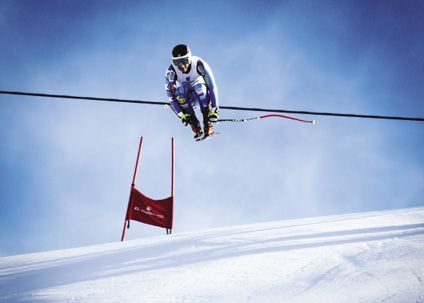
Courtesy Marco Sullivan.
Born in 1980, Sullivan grew up in the Tahoe City Trailer Park, fondly called “Sin City” or “Little India” by its residents. Located on the south bank of the Truckee River, just 200 yards from Lake Tahoe’s outlet dam, the park offered cheap rent in an idyllic setting. World-class climbers and skiers settled there, in trailers they expanded using recycled construction material from the era’s building boom. People didn’t bother to lock their doors; kids rode bikes and tossed footballs in the streets.
Photo above: Marco Sullivan celebrates his final World Cup race at Kvitfjell, Norway, in 2016.
Sullivan and his older sister, Chelsea, had the run of the place, loosely supervised by the neighbors, including their uncle, Mark “Sully” Sullivan, and his girlfriend, Debbie. Marco’s dad, Paul, operated heavy equipment for Perata Excavation, and mom Rena worked in human resources at Squaw Valley (now Palisades Tahoe), and waited tables in the evenings. The ski area job netted the family season passes.
Growing up, Paul and Mark had raced for the Lake Tahoe Ski Club. Mark would go on to coach at Squaw, ultimately managing the Squaw Valley Ski Team. “He took me to the World Cup in Heavenly when I was five, and I got a picture with Stenmark and Zurbriggen,” Marco recalls. “After that I was hooked.”
The Mighty Mites
Sullivan joined Squaw’s Mighty Mites, who progress from watching routes through the resort’s famed chutes and cliffs to pushing each other down and over them, bell to bell, day after day. Speed is the inevitable consequence, in the tradition of Jimmie Heuga and the Poulsen and McKinney kids. Sully famously attributed the perpetual flow of U.S. Ski Team stars to the “real head coach,” the peak called KT-22. According to Sully, repeatedly lapping KT’s 2,000 feet of continuous vertical rock and roll was all a kid needed to succeed.
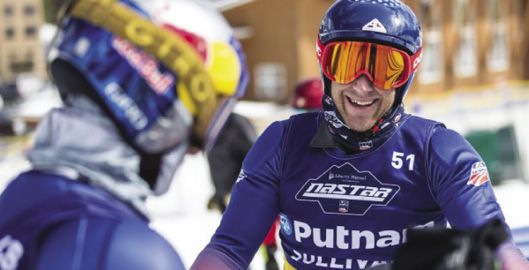
NASTAR National Pacesetter, succeeding
AJ Kitt. NASTAR photo.
Marco Sullivan embodied that. “Coming up through the ranks, I never felt like it was weird to want to be on the U.S. Ski Team or in the Olympics,” he recalls. “There were so many people around who had done it.” Watching over them all was his uncle, who made sure the Sullivan kids had everything from hand-me-down equipment to bunk space at training camps. “Ironically, Sully was never my actual on-hill coach, and I don’t remember receiving a lot of technical coaching from him,” says Sullivan of his uncle. “But he always ensured that I had the opportunities that were necessary.”
The term “coach” insufficiently captures what Sully did. He inspired, collaborated with, facilitated, entertained, bolstered and, mostly importantly, believed in the people around him. When he and fellow Far West coach Noel Dufty co-hosted an annual camp in New Zealand, an extraordinary run of World Cup speed skiers from the Western Region ensued.
Sully and Dufty championed a community approach to ski racing. “The whole idea was of working together and not worrying about who owns it,” says Dufty. “We took the good from all kids being together.” Sullivan took full advantage of the opportunities. Most of his pack attended North Tahoe High School, where they would start skiing at lunchtime and then take their afternoon classes as independent study.
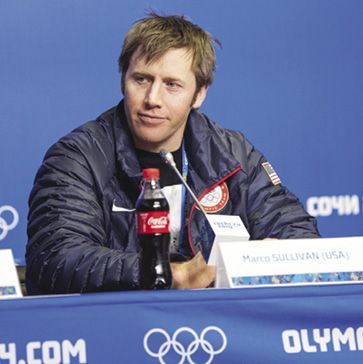
USSA photo.
The next piece fell in place when Trevor Wagner, fresh out of Sierra Nevada College (now University), joined Squaw’s coaching staff. Instead of logging gates and timed runs, the kids spent their competitive juices on KT. “Skiing faster than super G speed all the time, you get so comfortable with the speed that it feels normal,” says Wagner. “You start to look farther down the hill, your vision is longer, and everything slows down.”
Reacting to terrain also develops the elusive “touch” that no coach can teach. And for the Tahoe skiers, that translated into results. “When we hit FIS age, it was natural to be fast,” says Sullivan. “I never felt like there was a ton of pressure.”
The U.S. Ski Team and Beyond
In 1999, at age 18, Sullivan won the Junior National Championship Downhill at Snowbasin and was named to the U.S. Ski Team. During his first year on the team, he won a bronze medal in slalom at the 2000 World Junior Alpine Skiing Championships. The next day, he blew out his knee in the GS, which ended up forcing Sullivan to make a crucial career pivot.
“It hurt too much to come back skiing tech, so I gravitated to speed,” he explains. In December 2001 he started racing on the World Cup and made his Olympic debut two months later, at the Winter Games in Salt Lake City. He finished ninth in the downhill, the best finish for the U.S. team in that race. The following season, Sullivan won the U.S. Super G title—on his home turf at Squaw—and went on to compete in the 2006, 2010 and 2014 Olympics, and the 2003, 2007, 2009 and 2013 FIS Alpine World Ski Championships.
On the World Cup circuit, Sullivan established himself as an elite glider—comfortable at high speeds and calm in bumpy conditions. He missed two seasons, 2005 and 2011, due to injuries, but in 2007, he earned his first podium at the Lake Louise downhill. Later that season, he scored a downhill victory at Chamonix and finished fourth overall in the World Cup downhill standings.
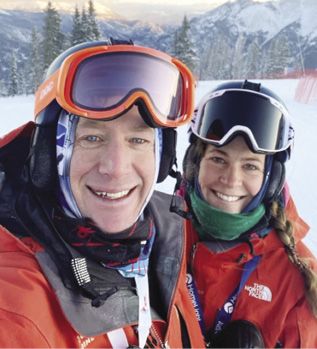
The couple coach the Palisades Tahoe
Ski Team.
Favorite Son
If Sullivan’s devoted fan base had a clubhouse, it would be Squaw’s Le Chamois. After Sullivan’s win in Chamonix, the “Chammy” hosted an epic welcome home celebration. Of all the legendary Squaw skiers, Sullivan may be the most beloved. During the heart of his career, 50-plus fans—led by his sister—convened for an annual pilgrimage to Beaver Creek for the Birds of Prey World Cup, packing the stands in their green “Marco Rocks” hats and “Marco for Mayor” buttons. They love Sullivan the athlete, but even more so the person; fun, humble, friendly and always giving back more than he receives.
Eddie Mozen started the Squaw Valley Masters Scholarship, which funded Sullivan for five years as a junior racer. Sponsored athletes are asked to give back to the skiing community. “Marco was the poster child,” says Mozen, who ticks off all the ways the racer gave back to the program, even for years beyond his sponsorship. “He ‘got it’ from day one.”
The Sully Legacy
Even as Sullivan found international success, his uncle, Sully, kept him grounded. “He just kept racing really simple,” says Sullivan. “He really believed in doing a few fundamentals correctly, not overanalyzing and always bringing humor to it.” Sully also made everyone—not just the stars—feel like a part of the team. “He did it in a way that was really subtle,” adds his nephew. “Nobody really realized what he was doing until he was gone.”
Sully passed away from cancer in 2014, at age 63.
American Downhiller
Sully’s influence lived on, specifically in Marco’s natural inclination to lift others up to enjoy the ride. In 2010, around the time when U.S. athletes first created their own websites, he passed on using marcosullivan.com, choosing instead AmericanDownhiller.com, a brand intended to be larger than himself. His teammates collectively adopted the term “American Downhiller,” celebrating their rogue spirit in the European-dominated sport.
The name evokes the go-for-broke culture embraced by U.S. speed skiers, the camaraderie built around a shared love of speed, courage in the face of danger, persistence in the face of adversity and brashness in the face of doubt. The crew built on longstanding traditions and added new ones, like an iconic beat-up jeans vest for the fastest American Downhiller of the week. Encouraged by his future wife, Canada’s World Cup slalom specialist Anna Goodman, Sullivan trademarked the term.
Sullivan retired in 2016, donning the ceremonial American Downhiller jean vest at the finish of his final World Cup race and getting doused in Champagne by teammates and competitors alike. He ran his last race at the U.S. Alpine National Championships in Sun Valley, dressed in lederhosen.
Sullivan ultimately earned three national titles, four World Cup podiums and one World Cup victory, and he quietly set the U.S. record for the most World Cup downhill starts, at 105. That’s one more than Bode Miller has. Significantly, Sullivan walked away healthy and still loving the sport, its own accomplishment.
Meanwhile, Anna had retired from World Cup racing in 2012 and pursued a degree in economics and conflict resolution at Westminster College in Salt Lake City while also racing for its ski team. In 2016, she and Sullivan settled back in Tahoe.
Soon after, Sullivan thought it would be cool to run an American Downhiller training camp with his buddies. The program launched in the spring of 2017. Helmet company POC jumped on board, creating American Downhiller gear and funding a series of short webisodes for Ski Racing. Those episodes evolved into the American Downhiller movie, showcasing the full cast of unsung heroes behind the hard-won successes.
The movie tapped into a past that had been largely ignored by the non-racing ski culture. “For these guys, being a downhiller was a footnote and all of a sudden it got brought back out,” says Sullivan. For downhillers to unite under one banner, which included welcoming women downhillers into the club and treating them with equal respect, took someone with Sullivan’s cred and humble demeanor.
The American Downhiller Camp
Just as the movie connected the athletes from past to present, the American Downhiller camps (spring in Mammoth, fall in Saas Fee) built a bridge between World Cup athletes and the kids. The star-studded coaching staff includes Alice McKennis Duran, Leanne Smith, Stacey Cook, Laurenne Ross, Daron Rahlves, AJ Kitt, Bryce Bennett and Steve Nyman. Lessons go beyond technique, including mental skills, which one typically learns only from experience. Says Sullivan, “A lot of what we teach is getting your mind in that capacity of wanting to go fast. Then fear goes away.”
Ultimately, he sees American Downhiller as a national platform from which to pass along a wealth of speed experience to successive generations of skiers. Anna’s business acumen and attention to detail complement her husband’s ambitious vision. In addition to the camps, weekend speed clinics take place at ski clubs across the country. “You can do a lot with a jump, a wave track and some glide turns,” says Sullivan. “You can work on the skills no matter where you happen to be.”
Last season Anna assumed the role of head FIS coach at Palisades Tahoe, while Sullivan took on the U-16 kids. He also has a side business making concrete countertops and furniture. One of his first commissions? The upstairs bar at Le Chamois.
In the summer, when they are not working at ski camps, the couple enjoys all that Tahoe offers, especially mountain biking. Before assuming year-round coaching duties, Anna had competed on cycling’s Enduro World Series tour. Now, when they get a break from camps, the pair load up the travel trailer for weekend trips. At the Lake Tahoe Ski Club annual fundraiser, Sullivan sets up tables while rallying support for the Sully Scholarship that he and his sister started. Every year, the scholarship goes to “an athlete who works hard, is a good teammate and is driven to achieve their goals in the sport of skiing.” Which is to say, an athlete in the Sullivan mold.
To those who suspect that speed events are dying at American ski resorts, Sullivan grins: “It’s not going anywhere. It’s always going to be there.” And it’s always going to be cool. 
Regular contributor Edith Thys Morgan spent nine years on the U.S. Ski Team, competing in three World Championships and two Olympics. She last wrote about “The Skiing Cochrans” in the May–June 2021 issue of Skiing History.
Table of Contents
WORLD CHAMPIONSHIP ($3,000+)
BerkshireEast/Catamount Mountain Resorts
Gorsuch
Warren and Laurie Miller
Sport Obermeyer
Polartec
CHAMPIONSHIP ($2,000)
Fairbank Group Resorts
Hickory & Tweed
Rossignol
Snowsports Merchandising Corporation
WORLD CUP ($1,000)
Aspen Skiing Company
Bogner of America
Boyne Mountain Resort
Dale of Norway
Darn Tough Vermont
Dynastar/Lange/Look
Gordini USA Inc/Kombi LTD
Head Wintersports
Intuition Sports
Mammoth Mountain
Marker/Völkl USA
National Ski Areas Association
Outdoor Retailer
Ski Area Management
Ski Country Sports
Sports Specialists LTD
Sun Valley Resort
Vintage Ski World
World Cup Supply
GOLD MEDAL ($700)
Larson's Ski & Sports
Race Place/Beast Tuning Tools
The Ski Company (Vicki and Gary Profetta)
Thule
SILVER MEDAL ($500)
Alta Ski Area
Boden Architecture PLLC
Dalbello Sports
Deer Valley
EcoSign Mountain Resort Planners
Elan
Fera International
Holiday Valley Resort
Hotronic USA
Masterfit Enterprises
McWhorter Driscoll LLC
Metropolitan New York Ski Council
Mt. Bachelor
New Jersey Ski & Snowboard Council
Russell Mace Vacation Homes
SchoellerTextil
Scott Sports
Seirus Innovations
SeniorsSkiing.com
Ski Utah
Steamboat Ski & Resort Corp
Sundance Mountain Resort
Swiss Academic Ski Club
Tecnica Group USA
Timberline Lodge and Ski Area
Trapp Family Lodge
Western Winter Sports Reps Association
World Pro Ski Tour
Yellowstone Club

